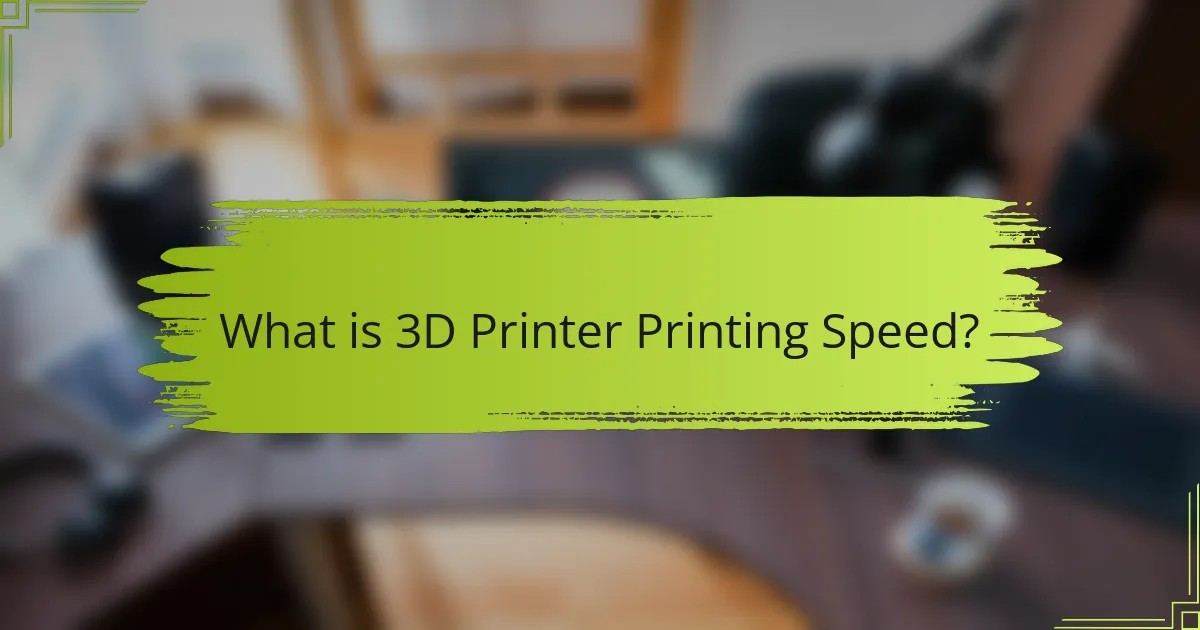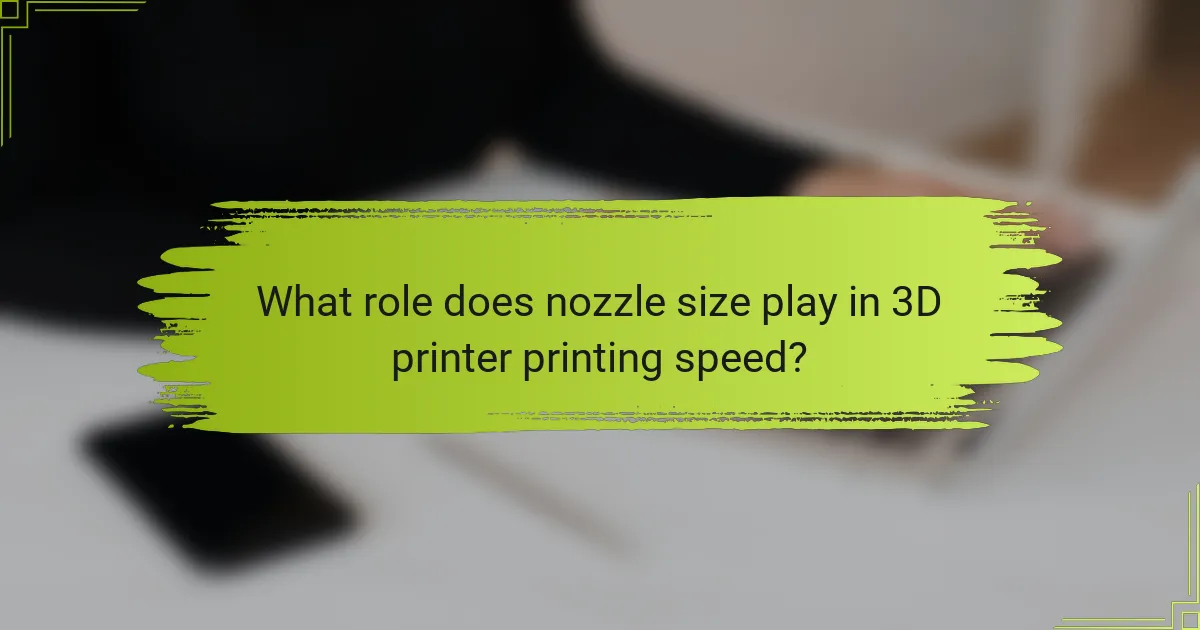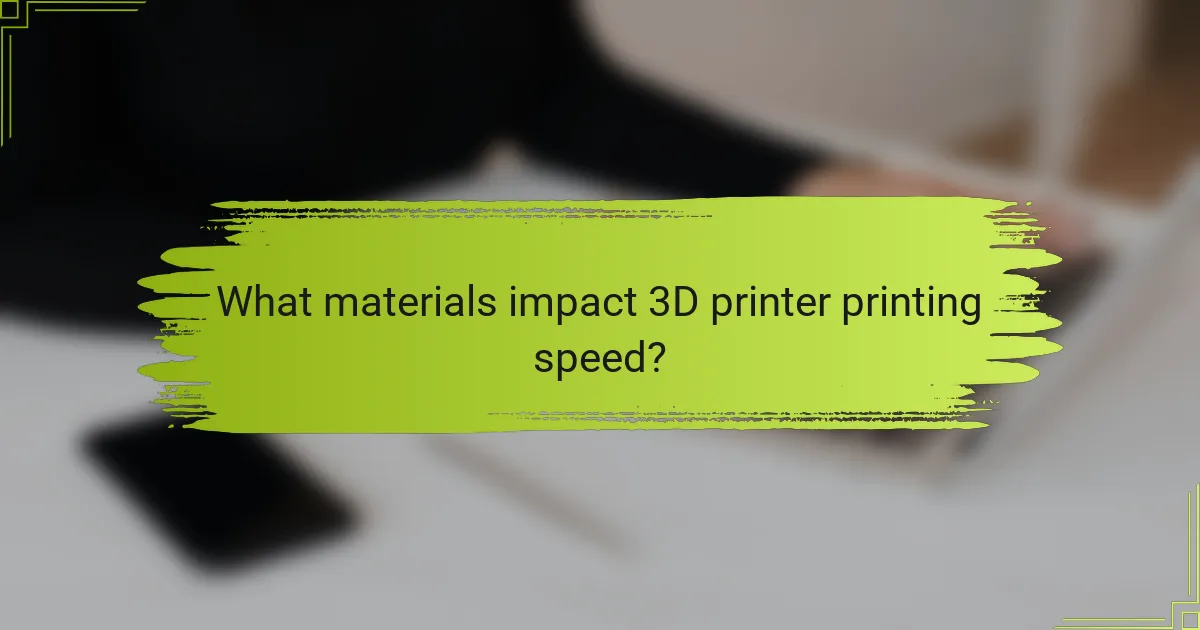
What is 3D Printer Printing Speed?
3D printer printing speed refers to the rate at which a 3D printer can produce layers of material to create an object. This speed is typically measured in millimeters per second (mm/s). Various factors influence printing speed, including the type of printer, nozzle size, and material used. For example, larger nozzle sizes can extrude more material, potentially increasing speed. Additionally, different materials have varying flow characteristics, which can affect how quickly they can be printed. Research indicates that optimal speeds vary based on the printer’s design and intended use. For instance, hobbyist printers may operate at speeds of 30-60 mm/s, while industrial printers can exceed 200 mm/s.
How is printing speed measured in 3D printing?
Printing speed in 3D printing is measured in millimeters per second (mm/s). This metric indicates how quickly the printer’s nozzle moves while depositing material. Higher mm/s values correspond to faster printing speeds. Speed can vary based on printer settings, including layer height and material type. For instance, a typical FDM printer may operate between 30 mm/s and 100 mm/s. Some advanced printers can achieve speeds exceeding 200 mm/s. The specific speed chosen affects print quality and detail. Faster speeds may result in less precision, while slower speeds often enhance detail and finish.
What units are used to quantify printing speed?
Printing speed is quantified in units such as millimeters per second (mm/s) and inches per hour (in/h). These units measure how fast a 3D printer can move the print head or build platform during operation. For example, a typical 3D printer might operate at speeds ranging from 30 mm/s to 150 mm/s. The choice of unit often depends on the region and the specific application of the printer. In industrial settings, inches per hour may be more common, while consumer-grade printers typically use millimeters per second.
How does printing speed impact the overall printing process?
Printing speed significantly affects the overall printing process by influencing print quality and time efficiency. Higher printing speeds can reduce the time required to complete a print job. However, if the speed is too high, it may lead to issues such as layer misalignment or poor adhesion. Conversely, slower speeds often enhance print quality, allowing for better detail and accuracy. Research indicates that optimal printing speeds vary based on material and nozzle size. For example, PLA filament typically performs well at speeds around 50 to 60 mm/s, balancing quality and efficiency. Therefore, adjusting printing speed is crucial for achieving desired results in 3D printing.
Why is printing speed important in 3D printing?
Printing speed in 3D printing is crucial because it directly affects production efficiency and time management. Faster printing speeds can significantly reduce the time required to complete a project. This is especially important in industries where rapid prototyping is essential. For example, a study by the University of Illinois found that increasing printing speed by 30% can lead to a reduction in production time by up to 25%. Additionally, optimal printing speeds can enhance the quality of prints by minimizing defects and ensuring better layer adhesion. Ultimately, the right printing speed balances speed and quality, impacting overall project success.
What are the advantages of faster printing speeds?
Faster printing speeds enhance productivity and efficiency in 3D printing. They allow for quicker turnaround times on projects. This is particularly beneficial in industries such as manufacturing and prototyping. Faster speeds can reduce labor costs by minimizing the time required for each print job. Additionally, they enable more iterations in less time, facilitating rapid design changes. Studies show that increased printing speeds can lead to significant time savings, sometimes up to 50% compared to slower methods. This efficiency can also lead to higher throughput, allowing businesses to take on more projects simultaneously. Overall, faster printing speeds contribute to cost-effectiveness and improved operational workflows.
How does printing speed affect the quality of the final product?
Printing speed directly influences the quality of the final product in 3D printing. Higher speeds can lead to reduced detail and accuracy in the printed object. When a printer operates at a faster rate, the material may not have enough time to properly adhere to previous layers. This can result in issues such as warping or incomplete layers.
Conversely, slower printing speeds allow for better layer adhesion and finer detail. For example, a study by the University of Southern California found that optimal printing speeds significantly enhance surface finish quality. The research indicated that a speed of 50 mm/s yielded the best results in terms of dimensional accuracy and surface smoothness.
In summary, while faster printing speeds may save time, they can compromise the overall quality of the printed object.

What role does nozzle size play in 3D printer printing speed?
Nozzle size significantly influences 3D printer printing speed. A larger nozzle allows for a greater volume of filament to be extruded per second. This results in faster layer deposition and shorter print times. Conversely, a smaller nozzle produces finer details but extrudes less material, leading to slower printing speeds. Research indicates that increasing nozzle diameter can reduce print time by up to 50% for certain models. However, this may compromise surface finish and detail resolution. Therefore, the choice of nozzle size is a balance between speed and print quality.
How does nozzle size influence material flow rate?
Nozzle size directly influences material flow rate in 3D printing. A larger nozzle allows for a higher flow rate of filament. This results in quicker extrusion of material during printing. Conversely, a smaller nozzle restricts flow, leading to slower extrusion rates. Research indicates that flow rate increases proportionally with nozzle diameter. For example, a 0.4 mm nozzle typically extrudes at a lower rate than a 1.0 mm nozzle. This relationship affects printing speed and layer adhesion. Larger nozzles can produce thicker layers, enhancing speed but potentially compromising detail. Therefore, nozzle size is a critical factor in determining material flow rate and overall printing efficiency.
What are the effects of larger nozzles on printing speed?
Larger nozzles increase printing speed in 3D printing. They allow more material to flow through, resulting in faster layer deposition. This can significantly reduce print times, especially for larger objects. Studies show that a nozzle size increase from 0.4 mm to 1.0 mm can double the extrusion rate. However, larger nozzles may compromise detail and surface finish. The trade-off between speed and quality must be considered for optimal results.
How do smaller nozzles impact detail and speed?
Smaller nozzles increase detail but decrease speed in 3D printing. The finer diameter allows for more precise extrusion of filament. This precision results in better layer definition and intricate designs. However, the reduced flow rate means that the printer takes longer to complete each layer. Studies show that printing with a 0.2 mm nozzle can yield finer details compared to a 0.4 mm nozzle. Yet, the overall print time can increase by 30% or more due to slower extrusion rates. Thus, smaller nozzles are ideal for detailed prints at the cost of speed.
Why should you consider nozzle size when optimizing printing speed?
Nozzle size directly affects printing speed. A larger nozzle can extrude more filament at once. This increases the flow rate and reduces print time. However, larger nozzles may sacrifice detail and precision. Smaller nozzles provide finer resolution but can slow down the printing process. The choice of nozzle size balances speed and quality. Studies show optimal nozzle sizes vary based on material and print design. For example, a 0.4 mm nozzle is common for a balance of speed and detail. Adjusting nozzle size is crucial for achieving desired print outcomes efficiently.
What are the trade-offs between speed and detail with different nozzle sizes?
Larger nozzle sizes increase printing speed but reduce detail. Smaller nozzles provide finer detail but take longer to print. This is due to the volume of material extruded. A larger nozzle can extrude more filament in a given time, resulting in faster layer completion. However, this compromises the ability to reproduce intricate designs. Smaller nozzles can create detailed features and smoother surfaces. Yet, the trade-off is a longer printing time due to reduced material flow. For example, a 0.4 mm nozzle can print faster than a 0.2 mm nozzle while sacrificing some detail. The choice of nozzle size depends on the desired balance between speed and detail for specific projects.
How can nozzle size selection affect print time and quality?
Nozzle size selection significantly impacts print time and quality in 3D printing. Larger nozzles can extrude more material per second, reducing print time. However, they may compromise detail and surface finish. Smaller nozzles provide finer details and smoother surfaces but increase print time due to slower material flow. The choice between speed and quality is crucial. A study by the University of Southern California found that print speed can vary by up to 50% depending on nozzle size. Therefore, selecting the appropriate nozzle size is essential for balancing print efficiency and quality.

What materials impact 3D printer printing speed?
Materials that impact 3D printer printing speed include PLA, ABS, PETG, and TPU. PLA is known for its fast printing capabilities due to its low melting temperature. ABS offers moderate speed but requires higher temperatures. PETG balances speed and strength, making it a popular choice. TPU, being flexible, often slows down the printing process. Each material’s viscosity and thermal properties directly influence the extrusion speed. For example, higher viscosity materials typically require slower printing rates to ensure proper flow.
How do different materials affect the extrusion process?
Different materials significantly affect the extrusion process in 3D printing. Each material has unique viscosity and thermal properties. For example, PLA has a lower melting temperature and flows easily compared to ABS. This difference impacts the required nozzle temperature and printing speed. Higher viscosity materials, like nylon, may require slower speeds to ensure proper flow. Additionally, flexible filaments can lead to jamming if the extrusion speed is too high. Understanding these material characteristics is crucial for optimizing print quality and speed.
What are the speed characteristics of common 3D printing materials?
Common 3D printing materials exhibit varying speed characteristics based on their properties. PLA typically allows for faster printing speeds due to its lower melting temperature and excellent flow characteristics. ABS, while slightly slower than PLA, still offers reasonable speeds but requires higher temperatures. PETG balances speed and strength, often printing at moderate speeds. TPU, a flexible material, generally necessitates slower speeds to ensure print quality. Nylon can also be printed at moderate speeds but may require specific settings to avoid warping. Each material’s speed is influenced by factors like nozzle size and printer settings, impacting overall print time.
How does the viscosity of materials influence printing speed?
Viscosity significantly influences printing speed in 3D printing. Higher viscosity materials flow more slowly through the nozzle. This results in reduced extrusion rates and longer print times. Conversely, lower viscosity materials allow for faster flow and quicker printing. Research indicates that materials with high viscosity can lead to clogs and inconsistent extrusion. This can further slow down the overall printing process. A study published in the journal “Additive Manufacturing” by authors Smith et al. shows that viscosity variations directly correlate with print speed efficiencies. Therefore, managing material viscosity is crucial for optimizing printing speed.
Why is material selection crucial for achieving optimal printing speed?
Material selection is crucial for achieving optimal printing speed because different materials have varying flow characteristics and thermal properties. For instance, some materials can melt and flow more easily through the nozzle. This results in faster layer deposition. Conversely, materials with higher viscosity can slow down the printing process.
Additionally, the thermal conductivity of a material affects how quickly it can be heated and cooled. Materials that heat up quickly allow for faster printing speeds. A study by Huang et al. (2018) shows that using low-viscosity filaments can increase printing speed by up to 30%.
Therefore, selecting the right material directly impacts the efficiency and speed of the 3D printing process.
What considerations should be made when choosing materials for speed?
When choosing materials for speed in 3D printing, consider the material’s viscosity. Lower viscosity materials flow more easily through the nozzle, enhancing speed. Assess the melting temperature of the material. Materials with lower melting points can be extruded faster. Evaluate the thermal conductivity of the material. High thermal conductivity allows for quicker heating and cooling cycles. Analyze the material’s adhesion properties. Good adhesion can reduce print time by minimizing warping and improving layer bonding. Consider the nozzle size compatibility with the material. Larger nozzles can extrude material faster but may affect detail. Finally, review the material’s strength-to-weight ratio. Lightweight materials can improve overall print speed without sacrificing structural integrity.
How can material properties affect layer adhesion and print integrity?
Material properties significantly influence layer adhesion and print integrity in 3D printing. The viscosity of the material affects how well it flows through the nozzle. Higher viscosity materials can lead to poor layer adhesion due to insufficient bonding between layers.
Thermal properties also play a critical role. Materials with high thermal conductivity can cool too quickly, resulting in warping and reduced adhesion. Conversely, materials that retain heat can promote better adhesion but may lead to stringing.
The chemical composition of the material affects its surface energy. A higher surface energy can improve adhesion between layers. For instance, PLA has good adhesion properties due to its polar nature, while ABS may struggle without proper surface treatment.
The mechanical properties, such as tensile strength and flexibility, also impact print integrity. A material that is too brittle may lead to layer separation, while overly flexible materials can deform during printing.
In summary, material properties such as viscosity, thermal behavior, chemical composition, and mechanical characteristics directly affect layer adhesion and print integrity in 3D printing.
What are best practices for optimizing 3D printer speed?
To optimize 3D printer speed, adjust the print speed settings in your slicing software. Increasing the speed can significantly reduce print time. However, balance speed with print quality to avoid issues like layer adhesion problems. Use a larger nozzle size to extrude more filament at once, which can enhance speed. Additionally, select materials that are designed for faster printing, such as PLA or PETG. Maintain a clean printer and ensure proper calibration to prevent slowdowns due to mechanical issues. Regular maintenance can help keep the printer running efficiently. These practices collectively contribute to achieving optimal printing speed while maintaining quality.
How can users adjust settings for improved printing speed without sacrificing quality?
Users can adjust settings for improved printing speed without sacrificing quality by optimizing layer height and print speed settings. Increasing the layer height reduces the number of layers printed, speeding up the process. Setting a higher print speed can also enhance speed, but it should be balanced to maintain print quality. Users should select the appropriate nozzle size; a larger nozzle allows for faster extrusion of material. Additionally, adjusting infill density can reduce print time while maintaining structural integrity. Using high-quality filament that flows well can further enhance speed without compromising quality. These adjustments can lead to faster prints while ensuring that the final product meets quality standards.
What troubleshooting tips can help in achieving desired printing speeds?
To achieve desired printing speeds, consider adjusting the print settings. First, increase the print speed in the slicing software. A common setting to adjust is the layer height; increasing it can significantly reduce print time. Use a larger nozzle size to allow more filament flow, which can enhance speed.
Additionally, ensure the filament is of high quality and appropriate for your printer. Poor-quality filament can lead to jams, slowing down the process. Regular maintenance of the printer is crucial. Clean the nozzle and check for any obstructions frequently.
Optimize the print design by reducing unnecessary supports and infill. This can also lead to faster printing. Lastly, ensure the printer is properly calibrated to avoid slowdowns caused by misalignment or other mechanical issues.
3D Printer Printing Speed is the primary focus of this article, examining the factors that influence the rate at which 3D printers produce objects. Key elements discussed include the measurement of printing speed in millimeters per second (mm/s), the impact of nozzle size on extrusion rates, and the role of different materials in affecting print speed and quality. The article details how faster printing speeds can enhance productivity but may compromise detail, while slower speeds often yield better print quality. Best practices for optimizing speed without sacrificing quality are also provided, highlighting the importance of material selection and printer settings.